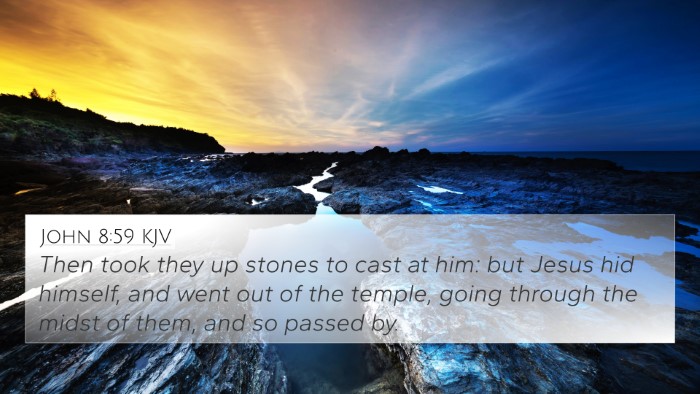Understanding Luke 4:30: Insights from Public Domain Commentaries
The verse Luke 4:30 states, "But he passing through the midst of them went his way." This passage comes in the context where Jesus has been preaching in Nazareth, and the people, initially amazed by his gracious words, turn hostile. They rise up against him and seek to throw him from the cliff. However, the moment escalates as Jesus demonstrates his divine authority by miraculously passing through the crowd unharmed.
Summary of Insights
Various commentaries provide a range of interpretations on this specific scripture:
-
Matthew Henry:
Henry discusses the significance of Jesus’ ability to escape. This escape illustrates not just his physical protection but his divine mission. He reflects on how every attempt to hinder the work of God ultimately proves futile.
-
Albert Barnes:
Barnes recognizes that this event illustrates the rejection Jesus faced from his own people. It also emphasizes that the truth can often provoke hostility, and though Jesus performed miracles, the hard-heartedness of the crowd blinded them to the truth.
-
Adam Clarke:
Clarke interprets this passage within the framework of Jesus' prophetic identity. His passing through the crowd without harm is a remarkable display of authority over his situation, indicating that no one can thwart God’s plans or timing.
Cross-References and Thematic Connections
Luke 4:30 connects with several other scripture passages, providing deeper insights into the text's meaning and overarching themes. Here are some of the notable cross-references:
- John 1:11: "He came to his own, and his own received him not." – This verse emphasizes the rejection Jesus experienced, echoing the sentiments found in Luke 4:30.
- Matthew 13:57: "A prophet is not without honor except in his own country and in his own house." – This scripture reflects on Jesus' familiarity breeding contempt among those who knew him well.
- Mark 6:5-6: "And he could do no mighty work there, except that he laid his hands on a few sick people and healed them." – Highlights the limited response to Jesus’ ministry in his hometown.
- Luke 19:10: "For the Son of Man came to seek and to save the lost." – Underlines the purpose of Jesus’ mission, providing further context to the hostility faced in his early ministry.
- Acts 17:5-7: Describes similar hostility faced by Paul, linking how the early believers also encountered rejection and violence.
- 1 Peter 2:7-8: "To you who believe, he is precious; but to those who are disobedient, the stone which the builders rejected has become the chief cornerstone." – Speaks to the theme of rejection and the reaction of different groups to Christ.
- Hebrews 12:2: "Looking unto Jesus, the author and finisher of our faith..." – A reminder of Jesus’ divine mission regardless of human opposition.
Broader Theological Implications
The implications of this verse stretch beyond its narrative context. It offers a powerful reflection on:
- Rejection of Truth: The hostility Christ faced reflects humanity's struggle to accept God’s truth, a recurring theme throughout Scripture.
- Divine Protection: Jesus’ ability to pass through the mob illustrates God’s sovereignty and protection over His messengers.
- The Role of Prophets: Jesus’ experience is not unique; it draws attention to how prophets throughout history often faced rejection.
- Mission of Salvation: Despite rejection, Jesus’ mission continues, showing that God's purpose transcends man's intentions.
- Hope Amidst Opposition: This narrative encourages believers facing challenges in their faith journeys, affirming that divine purpose prevails.
Cross-Referencing Techniques in Scripture Interpretation
To enhance understanding and interpretation of Luke 4:30 through cross-referencing, consider the following:
- Utilizing a Bible Concordance: A concordance can aid in locating scriptures that speak to similar themes of rejection and divine purpose.
- Bible Cross-Reference Guide: Such guides often provide quick pathways to related verses, enhancing thematic study.
- Cross-Referencing Bible Study Methods: Approaches like thematic studies can aid in building a comprehensive view of biblical teachings around rejection and prophecy.
- Identifying Connections Between Old and New Testament: Comparing these texts can highlight how previous messages foreshadow the coming of Christ and the challenges he would face.
- Comparative Study of Pauline Epistles: Analyzing Paul's writings provides a connection to the ongoing struggles of early Christians which parallels the narrative of Luke.
Conclusion
Luke 4:30 serves as a poignant reminder of Jesus’ early ministry challenges, reflecting deeper theological truths about rejection, divine purpose, and the prophetic role. By employing tools for cross-referencing and engaging in comparative verse analysis, one can unearth a rich tapestry of biblical connections that deepen understanding.
This exploration into Luke 4:30 encourages readers to look for similarities between verses, providing a continued call to insight through the Scriptures. The connections between Biblical texts not only illuminate the significance of individual verses but also foster a holistic understanding of the Biblical narrative.






